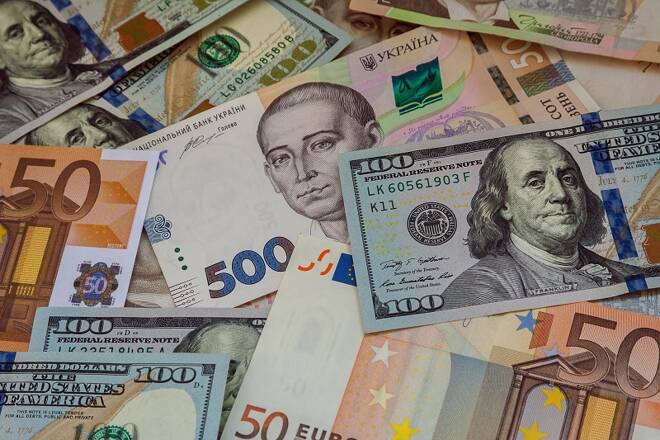Advertisement
Advertisement
Brexit and Trade Talk Overshadowed the Stats and Central Banks in the Week
By:
The Pound came out on top last week. Hopes of a delay to Brexit and expectations that Britain will not leave without a deal provided the upside. Trade talks also influenced as did central banks.
The Dollar
Thursday proved to be a moment of truth for the Dollar and the U.S economy.
A mixed view of the FOMC meeting minutes released on Wednesday left the data to do the talking on Thursday.
The Philly FED Manufacturing Index slid into negative territory for the first time since May 2016. On the durable goods orders for December, whilst overall orders rose by 1.2%, the more influential goods orders non-defense ex-air fell by 0.7%, following a 1% fall in November.
Further evidence of a weakening manufacturing sector came from a fall in the U.S Manufacturing PMI, from 54.9 to 53.7. According to prelim figures, a 17-month low was attributed to softer demand. Concerns over global trade and the economic growth outlook and adverse weather conditions weighed in the month.
In spite of the slowdown in manufacturing sector activity, service sector activity saw its sharpest pickup in activity since June 2018. The Service sector PMI rose from 54.2 to 56.2 in February, according to prelim figures. While demand waned across the manufacturing sector, the services sector saw the strongest rise in incoming new work since September 2018.
The ongoing trade war between the U.S and China has made the markets particularly sensitive to manufacturing data. The reality is, however, that the services sector now accounts for around 80% of the U.S economy. With the broader manufacturing sector continuing to see growth and service sector activity picking up, a 0.42% slide in the U.S Dollar Index (“DXY”) last week had little to do with the numbers. The FED’s relatively optimistic outlook on the economy was justified, as were the downside risks stemming from the ongoing trade war that was reflected in the manufacturing sector numbers.
The EURO,
Looking across to the Eurozone, the manufacturing sector contracted, while support from the services sector led to a rise in the composite, from 51.0 to 51.4. Unlike the U.S, the Eurozone’s economy is far more reliant on the manufacturing sector. A continued contraction in Germany’s manufacturing sector will continue to be the red flag for the bloc’s economy.
The EUR gained 0.35% against the U.S Dollar last week. Economic data alone would have placed the EUR under significant pressure. Risk sentiment and updates from the U.S – China trade talks provided the direction throughout the week.
A pickup in risk appetite weighed on the Dollar and the Japanese Yen through the week. The Japanese Yen fell by a further 0.2% to leave it down by 1.65% against the U.S Dollar for the current month.
For the Japanese Yen, stats through the week included December’s machinery orders, January’s trade data, prelim February Manufacturing PMI numbers, and January inflation figures. If there had been concerns over the outlook for the Japanese economy going into the week, the sentiment would have deteriorated further by the end of the week. Dire trade data, a fall in core machinery orders and a contraction in the manufacturing sector added to the doom and gloom.
The latest numbers and lackluster inflation suggests significantly more support is going to be needed to offset slowing demand. Bank of Japan Governor Kuroda spoke of the BoJ’s willingness to further ease monetary policy. The need may already be evident…
Brexit,
For the Pound, Brexit continued to be the key driver through the week. The Pound rallied by 1.27% against the Greenback for the week. The gains came in spite of some relatively disappointing employment figures released in the week.
A parliamentary rebellion continued, which led to the creation of the Independent Party. With the British government having failed to improve “The Deal”, the prospects of a no-deal departure appear to have diminished. At a minimum, hopes are of a delay to the departure date. The ever-optimistic “pro-remains” will be hoping for a 2nd EU Referendum. Such hopes supported the Pound through the week.
The Rest,
Elsewhere, the Aussie Dollar and Kiwi Dollar failed to make ground. The Aussie Dollar ended the week down 0.17%, with the Kiwi Dollar down by 0.32%. The losses came in spite of progress on trade talks between the U.S and China.
News of one of China’s ports banning the import of coal from Australia certainly didn’t help the cause for the pair. The downside, however, was more likely to be as a result of a shift in sentiment towards monetary policy. Concerns over the outlook for growth near-term continue to be a common topic of discussion across a number of central banks. While the RBNZ has remained upbeat, the RBA’s more negative cautions outlook weighed in the week.
For the Loonie, a further rise in crude oil prices provided much-needed support. The Loonie ended the week up 0.82% against the Greenback. The upside came in spite of disappointing December retail sales figures released on Friday.
Risk appetite from progress on trade talks and the impact on crude oil prices remained the key driver. The upside continued to be pinned back, however. Concerns over the global economic outlook and the Bank of Canada’s stance on monetary policy limit the upside.
About the Author
Bob Masonauthor
With over 28 years of experience in the financial industry, Bob has worked with various global rating agencies and multinational banks. Currently he is covering currencies, commodities, alternative asset classes and global equities, focusing mostly on European and Asian markets.
Advertisement
